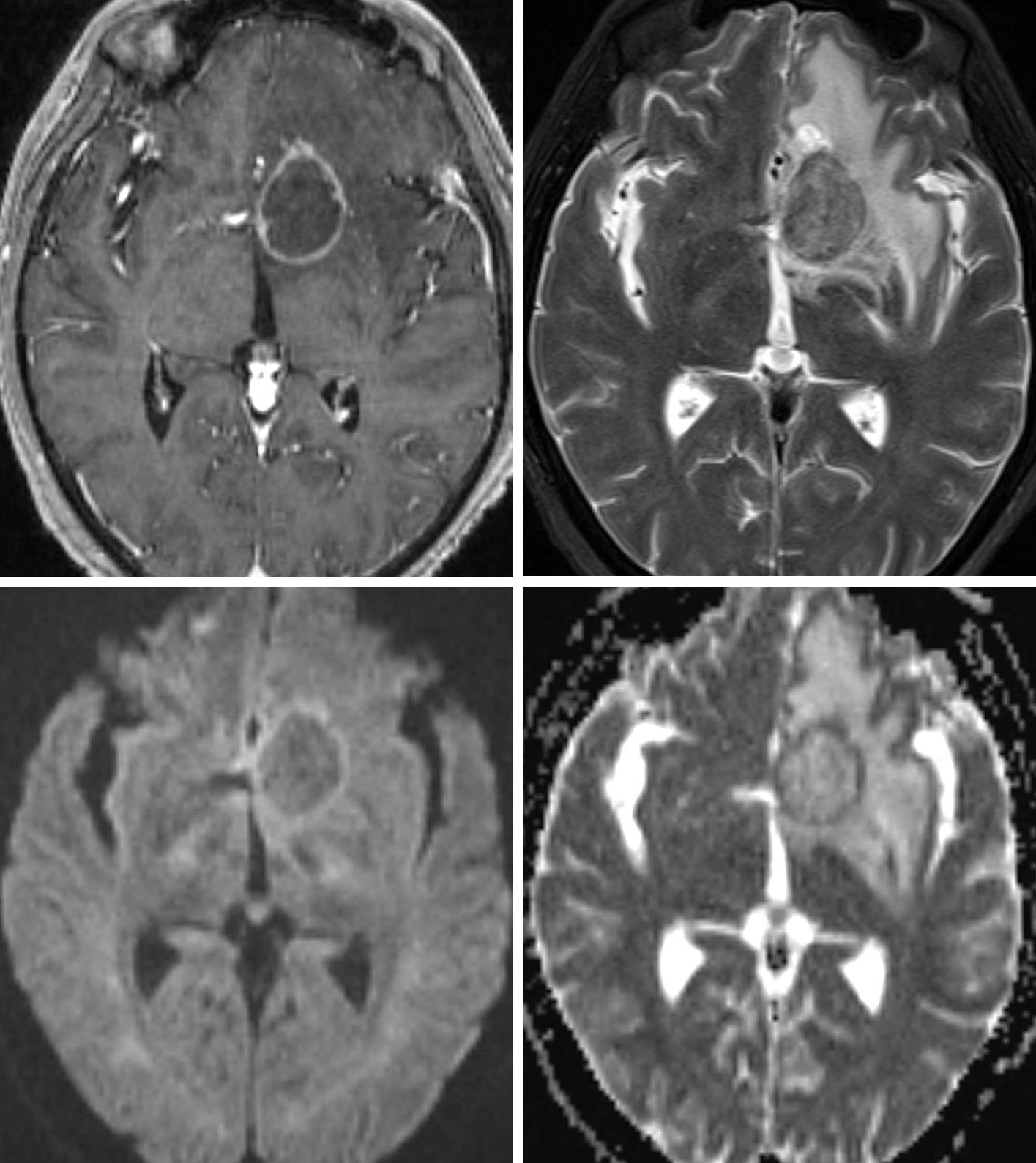Primary Central Nervous System Lymphoma
Figure 1: The patchy and solid enhancement of lymphoma on postcontrast T1WI (top left and top right) and abutment of an ependymal surface are typical in immunocompetent patients. This lymphoma crosses the midline through the anterior body of the corpus callosum. Low T2 (bottom right) and ADC (bottom left) signal indicate hypercellularity. This lymphoma is also inciting a moderate amount of T2-hyperintense area surrounding vasogenic edema.
Figure 2: This AIDS patient's inferior left frontal primary CNS lymphoma demonstrates a large amount of edema but is difficult to delineate on noncontrast CT imaging (left). After administration of contrast (right), the centrally necrotic lesion is more apparent.
Figure 3: Corresponding brain MRI for the patient in Figure 2. Axial T1-weighted postcontrast (top left), T2FS (top right), DWI (bottom row left), and ADC (bottom row right) images demonstrate a T2-hypointense, ring-enhancing mass with a rim of restricted diffusion. Note that centrally, the mass does not demonstrate restricted diffusion. The enhancement pattern and diffusion characteristics are compatible with this immunocompromised patient’s biopsy-proven B-cell lymphoma. An additional consideration for this immunocompromised patient before biopsy included toxoplasmosis, which can look identical to this case.
BASIC DESCRIPTION
- Extranodal malignant lymphoma arising in the central nervous system (CNS) without concurrent systemic lymphoma
- Primarily non-Hodgkin/diffuse large B-cell lymphoma
PATHOLOGY
- Associated with Epstein–Barr virus infection in immunocompromised patients
- Primary CNS lymphoma (PCNSL) is an AIDS-defining illness
- Malignant cells infiltrate perivascular spaces and blood vessels
CLINICAL FEATURES
- Immunocompetent: mean patient age, 60 years
- Immunocompromised (HIV/AIDS, post-transplant, inherited immunodeficiency such as Wiskott–Aldrich syndrome): younger ages
- Male gender predilection
- Common presenting signs/symptoms: altered mental status, focal neurologic deficits, cognitive decline, headache
- Treatment: biopsy, chemotherapy ± radiation; steroids can offer some short-term benefits
- Poor prognosis
- Immunocompetent patients: median survival, <5 years
- Immunocompromised status, multiple lesions, and older age are negative prognosticators
IMAGING FEATURES
- General
- Imaging appearance varies with immune status
- Hypercellular mass
- Well marginated or infiltrating
- Solitary or multiple
- Nearly always enhances, with homogeneous, patchy, and/or peripheral pattern
- Usually supratentorial and involving the periventricular white or deep gray matter
- Commonly spreads across corpus callosum or involves the ventricles
- Often abuts ependymal surface with subependymal spread
- Imaging appearance varies with immune status
- CT
- Hyperdense mass
- ± Necrosis, hemorrhage
- Homogeneous/patchy enhancement on contrast-enhanced CT; may be ring-enhancing if immunocompromised
- MRI
- T1WI: homogeneously isointense to hypointense; can appear heterogeneous due to necrosis or hemorrhage in the immunocompromised
- T2WI: homogeneously isointense to hypointense; can appear heterogeneous due to necrosis or hemorrhage in the immunocompromised
- FLAIR: homogeneously isointense to hypointense
- DWI: diffusion restriction is often seen, although an unreliable differentiator of glioblastoma (GBM)
- MR spectroscopy/MR perfusion: elevated Cho, decreased NAA; less relative cerebral blood volume (rCBV) elevation than GBM
IMAGING RECOMMENDATIONS
- MRI without and with intravenous contrast including DWI and MR perfusion
For more information, please see the corresponding chapter in Radiopaedia.
Contributor: Rachel Seltman, MD, and Jacob A. Eitel, MD
References
Abrey LE, Ben-Porat L, Panageas KS, et al. Primary central nervous system lymphoma: the Memorial Sloan–Kettering Cancer Center prognostic model. J Clin Oncol 2006;24:5711–5715. doi.org/10.1200/JCO.2006.08.2941.
Kleinschmidt-DeMasters BK, Damek DM, Lillehei KO, et al. Epstein Barr virus-associated primary CNS lymphomas in elderly patients on immunosuppressive medications. J Neuropathol Exp Neurol 2008;67:1103–1111. doi.org/10.1097/NEN.0b013e31818beaea.
Lee IH, Kim ST, Kim HJ, et al. Analysis of perfusion weighted image of CNS lymphoma. Eur J Radiol 2010;76:48–51. doi.org/10.1016/j.ejrad.2009.05.013.
Louis DN, Ohgaki H, Wiestler OD, et al. Malignant lymphomas. In: WHO Classification of Tumours of the Central Nervous System. IARC Press, Lyon, France; 2007:188–192.
Lu SS, Kim SJ, Kim N, et al. Histogram analysis of apparent diffusion coefficient maps for differentiating primary CNS lymphomas from tumefactive demyelinating lesions. AJR Am J Roentgenol 2015;204:827–834. doi.org/10.2214/AJR.14.12677.
Mansour A, Qandeel M, Abdel-Razeq H, et al. MR imaging features of intracranial primary CNS lymphoma in immune competent patients. Cancer Imaging 2014;14:22. doi.org/10.1186/1470-7330-14-22.
Matinella A, Lanzafame M, Bonometti MA, et al. Neurological complications of HIV infection in pre-HAART and HAART era: a retrospective study. J Neurol 2015;262:1317–1327. doi.org/10.1007/s00415-015-7713-8.
Osborn AG, Salzman KL, Jhaveri MD. Diagnostic Imaging (3rd ed). Elsevier, Philadelphia, PA; 2016.
Schlegel U, Schmidt-Wolf IG, Deckert M. Primary CNS lymphoma: clinical presentation, pathological classification, molecular pathogenesis and treatment. J Neurol Sci 2000;181: 1–12. doi.org/10.1016/s0022-510x(00)00385-3.
Please login to post a comment.














